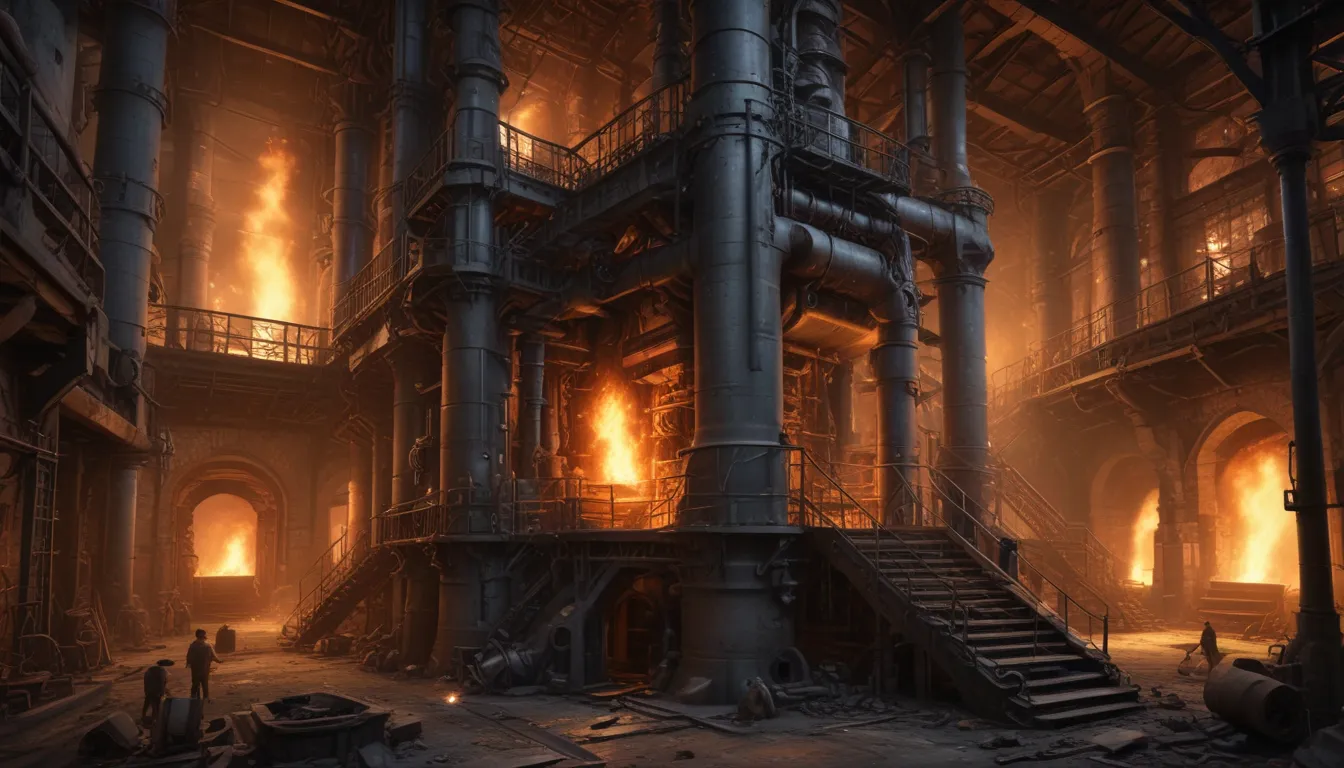A Note About Images: The images used in our articles are for illustration purposes only and may not exactly match the content. They are meant to engage readers, but the text should be relied upon for accurate information.
Are you ready to embark on a journey into the captivating world of blast furnaces? In this article, we will delve into 13 mind-blowing facts that will elevate your understanding of these industrial marvels. Blast furnaces stand as the cornerstone of the iron and steel industry, shaping the raw materials that underpin our modern society. While they may appear as towering behemoths, there is a wealth of complexity and ingenuity concealed within these structures. From the breathtaking temperatures and intricate chemistry at play to the profound historical significance they carry, prepare to be entranced by the enigmatic realm of blast furnaces. So, fasten your seatbelts and brace yourself for an educational and exhilarating exploration of the wonders held within blast furnaces!
Unveiling the Extraordinary World of Blast Furnaces
- Blast furnaces are monumental structures that operate at extreme temperatures, churning out thousands of tons of iron and steel daily. These giants have been instrumental in propelling economic progress and continually adapt with technological advancements.
- The exceptional engineering behind blast furnaces involves meticulous control of temperature, gas flow, and composition, alongside harnessing and repurposing byproduct gases. Their efficiency and adaptability render them indispensable to the future of the iron and steel industry.
Magnificently Massive Blast Furnaces
One of the most striking features of blast furnaces is their sheer magnitude. These towering structures can soar up to a height of 100 feet with a diameter of approximately 30 feet. The colossal size is imperative to accommodate the intense heat and requisite materials essential for the iron-making process.
Into the Inferno: Operating at Extreme Temperatures
Within the confines of the blast furnace, temperatures reach a scorching 2,800 degrees Fahrenheit (1,538 degrees Celsius). This intense heat is vital for melting the iron ore and catalyzing the chemical reactions pivotal for the production of iron and steel.
Delving into the Layers of Blast Furnaces
A standard blast furnace comprises multiple distinct layers. At the summit lies the charging zone where raw materials like iron ore, coke, and limestone are introduced. Beneath that lies the reduction zone, where the iron ore undergoes transformation into molten iron. Further down, the hearth harbors the molten iron, collected and periodically tapped.
Sustained by a Continuous Blast of Hot Air
Hot air is propelled into the blast furnace through nozzles called tuyeres. This air, frequently preheated for optimal efficiency, furnishes the oxygen necessary for coke combustion and the chemical reactions transpiring within the furnace.
Embracing a Counter-Current Flow Dynamics
A fundamental aspect of blast furnace functioning is the counter-current flow of materials and gases. As raw materials descend through the furnace, they intermingle with gases ascending from the hearth. This flow maximizes heat transfer efficiency and enhances chemical reactions.
Harnessing Byproduct Gases for Sustainable Utilization
Throughout the operation of the blast furnace, various gases are generated as byproducts, including carbon monoxide, carbon dioxide, and nitrogen. Instead of releasing these gases into the atmosphere, they are captured and repurposed in other industrial processes like electricity generation or chemical production.
Powerhouses of Production: High Capacities of Blast Furnaces
A solitary blast furnace showcases a remarkable ability to churn out thousands of tons of iron and steel daily. This impressive production capacity positions blast furnaces as pivotal in meeting the global demand for these essential materials.
An Enduring Legacy: Centuries of Utilization
The genesis of blast furnaces traces back to ancient China, where primitive prototypes were employed as early as the 2nd century BC. Across time, blast furnaces evolved and disseminated globally, evolving into the backbone of the iron and steel industry.
Precision in Practice: Mandating Precise Control
Operating a blast furnace necessitates meticulous regulation of diverse parameters. Factors like temperature, gas flow, and composition demand vigilant monitoring to ensure peak efficiency and quality of the iron and steel produced.
Efficiency Redefined: The Remarkable Efficacy of Blast Furnaces
Despite their monumental scale and substantial energy requisites, blast furnaces exhibit remarkable efficiency in converting raw materials into iron and steel. Ongoing technological enhancements have enabled blast furnaces to achieve heightened productivity levels while minimizing waste and energy consumption.
Slag: The Versatile Byproduct
While often overlooked, blast furnace slag holds versatile applications. This byproduct of the iron-making process can be repurposed as a raw material in cement production, road construction, and even as an aggregate in asphalt mixes. This innovative reuse reduces waste and transforms it into a valuable resource.
Catalysts of Economic Growth
The iron and steel industry, heavily reliant on blast furnaces, assumes a crucial role in fostering economic expansion. It generates employment opportunities, stimulates local businesses, and contributes to infrastructure development, driving progress on multiple fronts.
Embracing Evolution: The Continuous Refinement of Blast Furnaces
The iron and steel industry stands at the precipice of ongoing evolution, with a primary focus on advancing blast furnace technology. Innovations strive to enhance efficiency, reduce emissions, and bolster sustainability, securing the enduring relevance of blast furnaces in the industry’s future.
Unveiling the Marvels of Blast Furnaces: A Conclusion
In conclusion, blast furnaces stand as remarkable structures that command a pivotal role in the creation of iron and steel. These colossal entities possess the capacity to produce vast quantities of metal while navigating through scorching temperatures and intricate chemical reactions. From their historical significance to their innovative design, blast furnaces persist as an integral component of the manufacturing sector.
Whether you harbor enthusiasm for chemistry or simply crave insight into industrial processes, delving into the realm of blast furnaces can expand your knowledge and appreciation for the domain of metallurgy. From the intense heat generated to the complex reactions unfolding, blast furnaces illuminate the realms of human ingenuity and the wonders of chemistry.
FAQs: Unraveling the Enigma of Blast Furnaces
Q: What is a blast furnace?
A: A blast furnace stands as a colossal structure employed in the production of iron and steel, utilizing high temperatures to extract iron from raw materials like iron ore, coke, and limestone, generating molten metal.
Q: How does a blast furnace function?
A: A blast furnace operates through a process termed smelting, where raw materials are introduced at its zenith and gradually descend towards the base while intense heat is applied from below. This heat triggers chemical reactions, culminating in the extraction of molten iron.
Q: What are some key components of a blast furnace?
A: Key components of a blast furnace encompass the stack, hearth, bosh, tuyeres, and the charging system. Each component assumes a critical role in ensuring efficient furnace operation and iron extraction.
Q: What temperatures can a blast furnace reach?
A: Blast furnaces can attain temperatures as high as 2,700 degrees Fahrenheit (1,500 degrees Celsius) to facilitate the chemical reactions imperative for extracting molten iron.
Q: Are blast furnaces still utilized today?
A: Yes, blast furnaces retain their relevance in contemporary times for the production of iron and steel. Despite emerging technologies, blast furnaces endure as a vital and efficient mechanism for large-scale metal extraction.
Embark on a captivating journey into the world of blast furnaces and uncover the extraordinary marvels nestled within these industrial titans. The interplay of science, engineering, and innovation culminates in the awe-inspiring realm of blast furnaces, underscoring their immense significance in shaping the fabric of our modern world. As you bask in the splendor of these colossal structures, let your curiosity be ignited and your appreciation for industrial ingenuity be deepened.
Embracing Our Commitment to Excellence
Our unwavering dedication to delivering reliable and engaging content forms the cornerstone of our mission. Each fact presented on our platform stems from real contributors like you, enriching our repository with diverse insights and information. To uphold the highest standards of accuracy and authenticity, our vigilant editors meticulously scrutinize every submission. This meticulous process ensures that the facts we impart are not just captivating but also credible. Trust in our unwavering pledge to quality and authenticity as you venture and learn alongside us.






